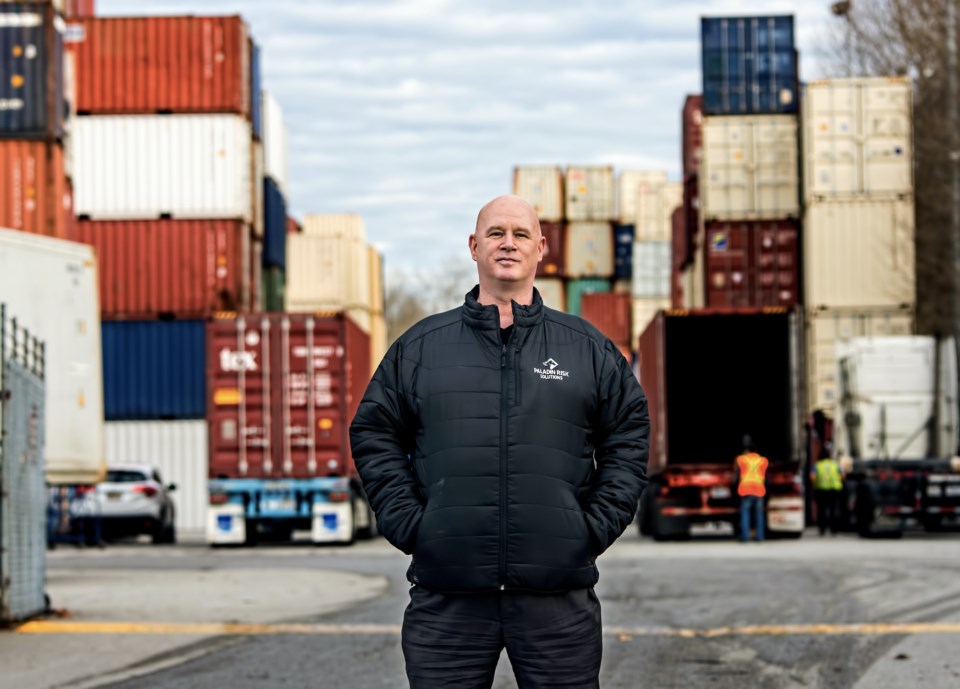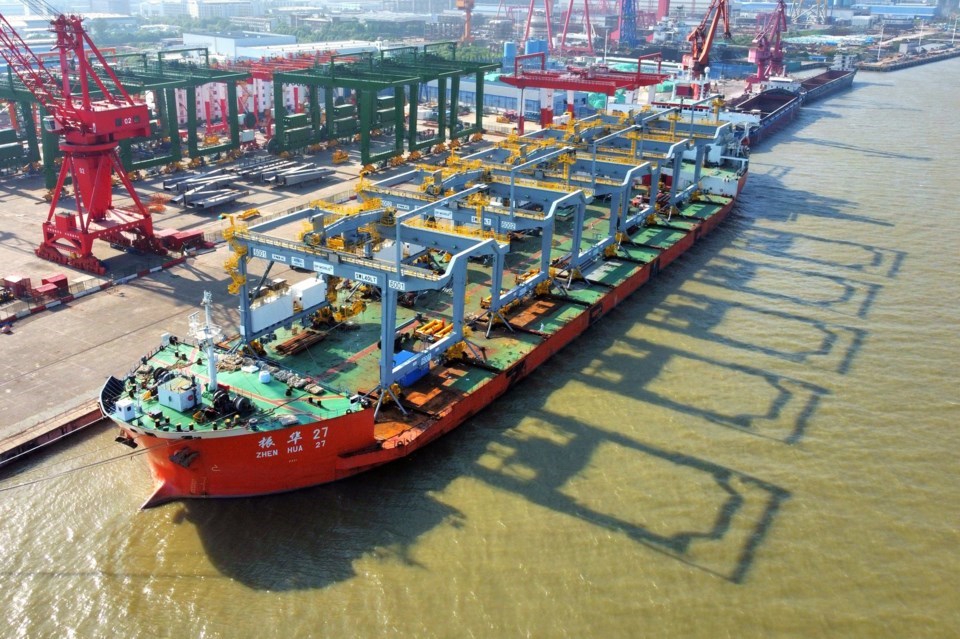British Columbia’s major shipping container terminals are outfitted with cranes manufactured by a Chinese company that has sparked a national cybersecurity probe in the United States.
U.S. officials allege they found undisclosed communications components, including cellular modems, on cranes exported by Shanghai Zhenhua Heavy Industries Company (ZPMC) to U.S. ports.
The cybersecurity concerns were serious enough to warrant public disclosure and a special directive from the White House last month, to begin manufacturing such cranes in America.
And it is those concerns that should be heeded by Canadian officials, according to two national security experts here in B.C.
“While Canada still has an existing agreement with the U.S. under the Five Eyes, it would behoove Canada to work with Americans to identify, disrupt and mitigate any efforts by the Chinese to install software in critical Canadian infrastructure, such as these cranes,” said Scott McGregor, a retired military and RCMP intelligence official.
McGregor calls the cybersecurity concerns “credible,” likening them to that of Huawei, which is now banned from Canada’s 5G cellular network.
“This is nothing new. This is a continuation of hybrid warfare efforts conducted by the Chinese,” said McGregor, whose book Mosaic Effect chronicles Chinese Communist Party (CCP) political activity in B.C.
Calvin Chrustie, a retired RCMP transnational crime investigator and partner at the intelligence and security firm Critical Risk Team, said revelations about the crane components are just one part of a broader effort by China to destabilize the economies of America and its allies.
Chrustie said the Chinese government could interfere with port communications to disrupt economic activity in its favour; and it could do so while leveraging transnational organized crime groups.
“If they want to move illicit commodities through our ports, through human resources, i.e., transnational organized crime networks, they also have to have the technology to assist and support them,” said Chrustie.

ZPMC ship-to-shore cranes ubiquitous in B.C.
At issue is “ship-to-shore” (STS) cranes manufactured by ZPMC. These are the familiar, large steel structures shooting skyward from port terminals — such as at Deltaport, Vancouver Terminal and Fairview Container Terminal (in Prince Rupert) — that move containers between ships and land.
As recently as February 2022, container terminal operator DP World accepted two new super post-Panamax cranes from ZPMC.
“The cranes were constructed entirely in China and, there, outfitted with state-of-the-art smart technology, which will automate many of the repetitive elements of the lifting cycle,” the operator stated online.
In June 2021, DP World accepted what was then the largest quay crane in Canada in Prince Rupert.
“The ZPMC crane comes with the latest technology and energy efficiency available,” the Chamber of Shipping reported.
Global Container Terminals Inc. (GCT) also has ZPMC cranes in Vancouver and at Deltaport, the province’s flagship terminal.
However, according to GCT spokesperson Marko Dekovic, its STS cranes do not use ZPMC crane control systems to operate the system.
Rather, “our crane control systems are sourced from software and hardware providers from Europe (Sweden) and North America. As such, we do not have any concerns,” Dekovic told Glacier Media via email.
In 2015, ZPMC touted GCT as its “first customer outside China” with “a long-standing relationship with the company.”
Then, Deltaport had just added two more post-Panamax cranes at Deltaport, for a total of 12 such ZPMC cranes, according to a news release.
Spokespersons at Port Metro Vancouver and Port of Prince Rupert, B.C.’s two chief port authorities, both said they do not have control of what equipment is used by container terminal operators, who lease space from the authorities.
Glacier Media reached out to Transport Canada, which regulates the authorities and terminals, to understand if it shares the concerns raised by U.S. officials.
“Transport Canada works with security partners and stakeholders, including those in the United States, to identify and mitigate security threats to Canada’s marine transportation system,” stated a spokesperson by email.
Congressional committees probe Chinese crane manufacturer's links to Chinese military, CCP
Last month, the Committee on Homeland Security called on ZPMC to answer questions about its crane production and potential ties to Chinese military and intelligence units.
In a Feb. 24 letter to ZPMC, via the U.S. Congress, the chairs of the Committee on Homeland Security and Select Committee on China outlined their findings and concerns and posed questions to the company, which is said to have supplied 80 per cent of cranes to U.S. ports.
In noting ZPMC is a subsidiary of China Communications Construction Company (CCCC) — “one of the main contractors for the CCP’s Belt and Road Initiative, with known ties to the People’s Liberation Army Navy (PLAN)” — the letter stated U.S. federal law enforcement agencies had discovered “ZPMC technicians, engineers, or other personnel installed certain components, including cellular modems, onto U.S.-bound STS cranes and other onshore maritime infrastructure.
“These components do not contribute to the operation of the STS cranes or maritime infrastructure and are not part of any existing contract between ZPMC and the receiving U.S. maritime port.”
Furthermore, “some of these modems were found to have active connections to the operational components of the STS cranes.”
The joint committees stated that “while [People’s Republic of China] government officials and various maritime stakeholders, including the American Association of Port Authorities, have previously dismissed the suggestion of this threat as ‘overly paranoid’ or ‘alarmist,’ the Committees have found otherwise.”
The letter also raises the issue of the company maintaining an internal “Communist Party Committee” and taking Chinese government subsidies, allowing it to gain a foothold on the global marine crane market by submitting “unusually low bids for U.S. port contracts,” thus “furthering the CCP’s economic influence within the U.S. maritime sector.”
“Our nation’s dependence on PRC state-owned enterprises, including ZPMC’s port equipment, for international trade, and the lack of sufficient domestic industrial alternatives, introduces significant risk of future exploitation by the CCP, putting the American people in potential danger in future national emergencies,” the committees wrote.
It is not clear what exactly the extra devices are intended to do.
“The Committees have been unable to verify a timeline for installation or their intended purpose. Certain U.S. seaport personnel have communicated to the Committees that they believed the cellular modems were potentially for maintenance, monitoring, or the collection of usage data for the STS cranes,” the letter states.
But the committees note there is the prospect of espionage and sabotage particularly since the ZPMC facility is located next to the PLAN's main shipyard.
“The Committees have serious concerns that this proximity to the PLAN’s main shipyard provides malicious CCP entities, including its intelligence agencies and security services, with ample opportunity to modify U.S.-bound maritime equipment, exploit it to malfunction, or otherwise facilitate cyber espionage thereby compromising U.S. maritime critical infrastructure,” the letter states.
ZPMC issued a statement online March 10, stating it “takes these allegations seriously and considers that such reports, without sufficient review of facts, can easily mislead the public.”
ZPMC asserted the cranes are used in ports around the world, comply with international standards and “pose no cybersecurity risk to any port.”
The committees asked ZPMC to provide answers to their questions by March 14.



